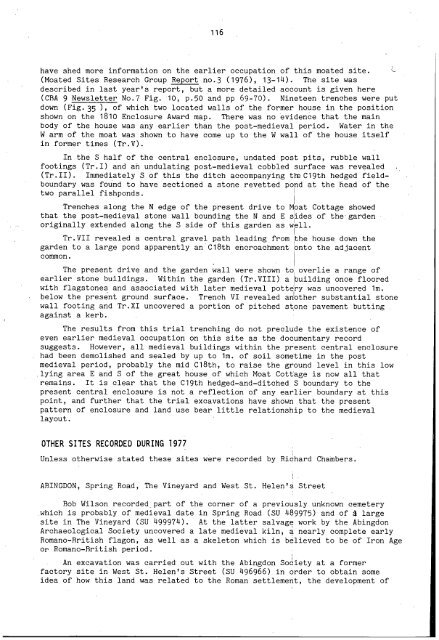Untitled - Council for British Archaeology
Untitled - Council for British Archaeology
Untitled - Council for British Archaeology
- No tags were found...
You also want an ePaper? Increase the reach of your titles
YUMPU automatically turns print PDFs into web optimized ePapers that Google loves.
116have shed more in<strong>for</strong>mation on the earlier occupation of this moated site.(Moated Sites Research Group Report no.3 (1976), 13-14). The site wasdescribed in last year's report, but a more detailed account is given here(CRA 9 Newsletter No.7 Fig. 10, p.50 and pp 69-70). Nineteen trenches were putdown (Fig.35 ), of which two located walls of the <strong>for</strong>mer house in the positionshown on the 1810 Enclosure Award map. There was no evidence that the mainbody of the house was any earlier than the post-medieval period. Water in theW arm of the moat was shown to have come up to the W wall of the house itselfin <strong>for</strong>mer times (Tr.V).In the S half of the central enclosure, undated post pits, rubble wallfootings (Tr.I) and ah undulating post-medieval cobbled surface was revealed(Tr.II). Immediately S of this the ditch accompanying tfeC19th hedged fieldboundarywas found to have sectioned a stone revetted pond at the head of thetwo parallel fishponds.Trenches along the N edge of the present drive to Moat Cottage showedthat the post-medieval stone wall bounding the N and E sides of the gardenoriginally extended along the S side of this garden asTr.VII revealed a central gravel path leading from the house down thegarden to a large pond apparently an Cl8th encroachment onto the adjacentcommon.The present drive and the garden wall were shown to overlie a range ofearlier stone buildings. Within the garden (Tr.VIII) a building once flooredwith flagstones and associated with later medieval pottery was uncovered lm.below the present ground surface. Trench VI revealed anlother substantial stonewall footing and Tr.XI uncovered a portion of pitched stone pavement buttingagainst a kerb.The results from this trial trenching do not preclude the existence ofeven earlier medieval occupation on this site as the documentary recordsuggests. However, all medieval buildings within the present central enclosurehad been demolished and sealed by up to lm. of soil sometime in the postmedieval period, probably the mid Cl8th, to raise the ground level in this lowlying area E and S of the great house of which Moat Cottage is now all thatremains. It is clear that the Cl9th hedged-and-ditched S boundary to thepresent central enclosure is not a reflection of any earlier boundary at thispoint, and further that the trial excavations have shown that the presentpattern of enclosure and land use bear little relationship to the medievallayout.OTHER SITES RECORDED DURING 1977Unless otherwise stated these sites were recorded by Richard Chambers.ABINGDON, Spring Road, The Vineyard and West St. Helen s StreetBob Wilson recorded part of the corner of a previously unknown cemeterywhich is probably of medieval date in Spring Road (SU 489975) and of 4 largesite in The Vineyard (SU 499974). At the latter salvage work by the AbingdonArchaeological Society uncovered a late medieval kiln, i nearly complete earlyRomano-<strong>British</strong> flagon, as well as a skeleton which is believed to be of Iron Ageor Romano-<strong>British</strong> period.An excavation was carried out with the Abingdon Soéiety at a <strong>for</strong>merfactory site in West St. Helen's Street (SU 496966) in order to obtain someidea of how this land was related to the Roman settlement, the development of
















